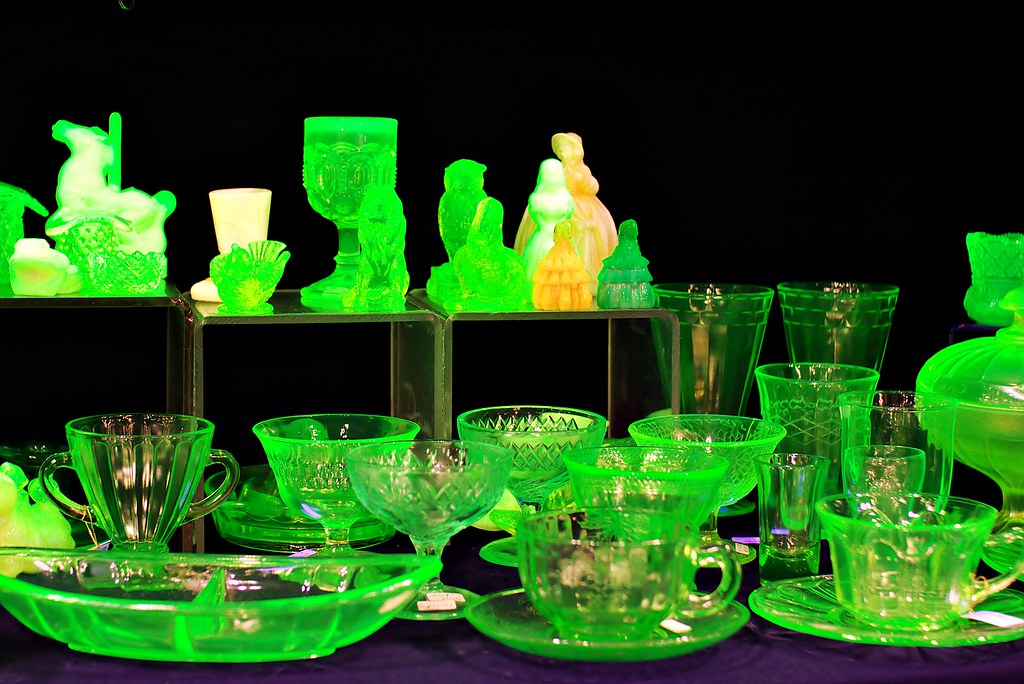Is Uranium Glass Safe? A Guide to Collecting Uranium Glass

Uranium glass has been captivating collectors for over a century with its vibrant green hues under UV light, making it a standout in any collection. But let’s face it: Seeing the word “uranium” can make even the most seasoned collectors raise an eyebrow... Or two.
So, the big question: Is uranium glass safe?
A Quick Intro: What Even Is Uranium Glass?
You might have heard it called Vaseline glass, not because it’s greasy, but because of its soft yellow-green shine.
- How it’s made: Tiny amounts of uranium oxide are added to molten glass and create that colored and magically fluorescent glow we all love to see under a black light.
- Backstory: Uranium glass was all the rage in the 1800s through the early 1900s and came in everything from fancy bowls to vases to tableware. You can even find uranium glass jewelry, like brooches.
- The Glow: When a UV light hits it, uranium glass practically lights up the room with a neon green flash. It’s mesmerizing.
What Is Uranium Glass?
Yes, uranium glass is technically radioactive. But before you panic and hide your collection in a lead vault, let’s break it down:
- Radiation Levels: Mostly alpha particles that can’t even get through your skin. Beta and gamma rays? Barely measurable.
- Perspective Check: You receive more radiation from hanging out on a granite countertop or taking a flight than from displaying uranium glass.
- Handling Safety: Decades of collectors have kept it on shelves with zero health scares, making it more sparkly than it'll ever be scary.
Is Uranium Glass Safe to Use?
Thinking about pouring your lemonade into a uranium glass cup? Perhaps slow things down and consider a few things first.
- Food & Drink: Avoid acidic foods and beverages that are more than likely going to leach traces of metals.
- Microwave? Nope: Metal in the glass + microwaves = drama that you're definitely not going to want (trust us, someone learned the hard way so you don't have to...)
- Cleaning: Ditch the harsh chemicals and abrasive scrubs. Remember to wash your uranium glass gently by hand.
Pro tip: Uranium glass shines best as a decorative element. Think candle holders, quirky jars, or statement pieces that your tableware will absolutely survive without.
How to Identify Uranium Glass
Some knock-offs might mimic that glow with glow-in-the-dark paint, but real uranium glass doesn't have to be hard to spot:
- Black Light Test works by shining a UV light on the glass and observing a bright green glow, which typically indicates that it’s authentic uranium glass. (Looking for the right black light? Try this 395nm from Amazon, or invest in a 365nm to help spot additional glowers like cadmium glass.)
- Color Check to find the classic shades of yellow, green, or a mix that seemingly glows from the inside out.
- Transparency is easy to spot because uranium glass or vaseline glass isn’t opaque. Remember, light should pass through easily and enhance the appearance.
- Weight and Feel can give clues, with many pieces having a solid, slightly heavy feel that hints at their vintage origins.
- Patterns and Etching are known to include intricate designs, swirls, and pressed motifs that highlight the glass’s color under light.
And hey... Hardcore collectors are sometimes known to even bring out a Geiger counter when on the hunt for collectible uranium glass... And we’re not judging!
Collecting Tips
Here’s why uranium glass makes collectors swoon:
- Hot Pieces: Bowls, vases, cups, tableware—the older, the better.
- Value Boosters: Pay close attention to the patterns, condition, and color intensity of a piece.
- Display Magic: A simple UV lamp or blacklight can transform any shelf into an instant conversation starter (because, let's be honest, who can resist that beautiful green glow?).
Bottom Line

Uranium glass is safe to admire, easy to handle, and more than a little fun to collect, and if you're worried about any radioactive vibes you might be inviting into your home... Don't stress. Radioactivity is minimal and can be perfectly fine to display in your home. Use it decoratively, respect the food and drink rules (if you're set on actually using it), and enjoy a piece of history in all its glory.
FAQ: Uranium Glass
Q: What is uranium glass?
A: Uranium glass, also known as Vaseline glass, is a collectible glass that contains small amounts of uranium oxide. It’s known for its yellow-green color and glowing fluorescence under UV or blacklight.
Q: Is uranium glass safe to display or use?
A: Yes. Uranium glass emits very low levels of radiation, mostly alpha particles that cannot penetrate skin. Uranium glass is safe to display in your home; however acidic foods or hot liquids may cause minor leaching if used for drinking.
Q: How can I identify authentic uranium glass?
A: Real uranium glass glows bright green under a UV or blacklight. Check for classic yellow-green shades, good transparency, weight typical of vintage pieces, and patterns or etching that highlight the color.
Q: What makes uranium glass collectible?
A: Collectibility depends on age, color intensity, pattern, and condition. Older bowls, vases, tableware, and jewelry pieces are especially sought after by collectors. Limited editions or unusual designs often fetch a higher value.
Q: Where can I buy uranium glass?
A: You can find uranium glass at antique shops, estate sales, auctions, online marketplaces like eBay or Etsy, and collector shows. Networking with other enthusiasts can also lead to rare finds.
Q: Can I drink from uranium glass?
A: While technically possible, it’s best to use uranium glass decoratively. Avoid acidic or hot beverages, and many uranium glass collectors prefer to keep these pieces as display items to preserve their condition and safety.



